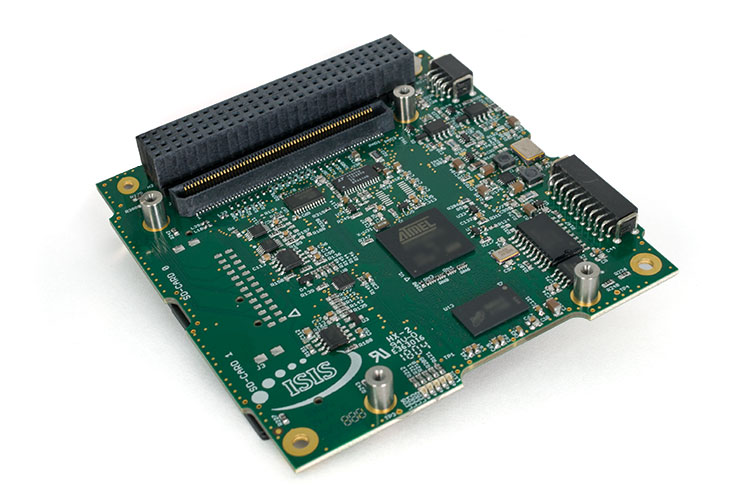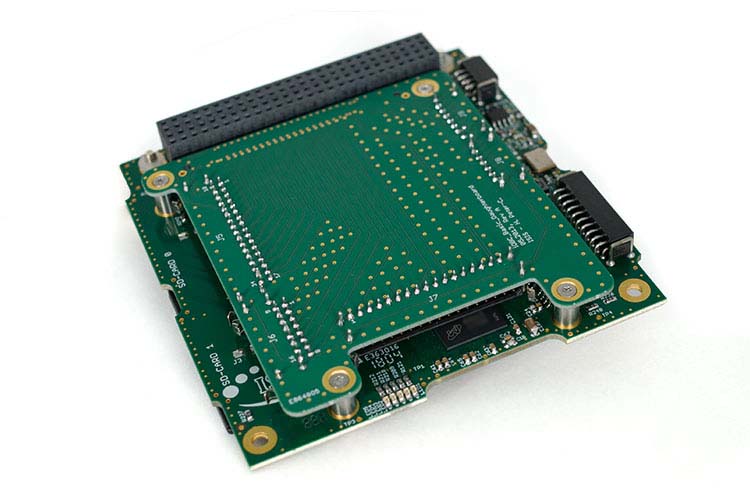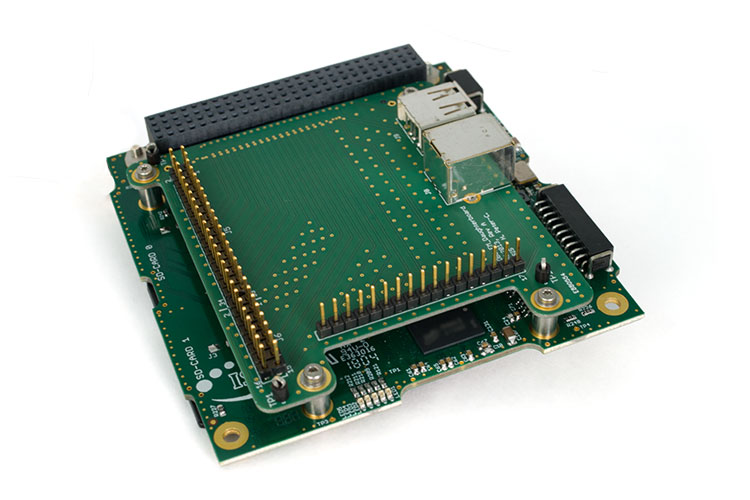ISIS On Board Computer
- 400 MHz, power efficient ARM9 processor
- FreeRTOS operating system for simple and lightweight cooperative multitasking
- On-board telemetry: voltages, power-controller, and real time clock
- High reliability data storage and fail safe filesystem
- Flexible daughterboard architecture
- Robust design
- Includes Hardware Abstraction Layer Library
- Compliant with CubeSat standard
Description
The ISISPACE On Board computer (IOBC) is a flight-proven, high-performance processing unit based around an ARM9 processor with a speed of 400 MHz, making it one of the most capable on-board computers for CubeSats, currently available on the market within the same price range. Its pluggable daughter board offers additional flexibility and customizability by providing a wide range of extra interfaces for payloads, sensors or actuators in a compact form factor.
Specifications
| Mass | 94g mainboard only, 100g with EM daughter board |
| Dimensions: | 96 x 90 x 12.4 [mm] (including FM daughter board) |
| Power Consumption: | 400mW average |
| Power Supply: | 3.3V |
| Operating Temperature: | -25 degC to +65 degC |
| Processor: | 400MHz 32-bit ARM9 processor |
| Volatile Memory: | 64MB SDRAM |
| Code Storage: | 1MB NOR Flash |
| Critical Data Storage: | 512kb FRAM |
| Mass Data Storage: | 2 x 2GB high reliability SD cards for fail safe data storage (up to 32 GB on request) or 2x any size standard SD cards |
Interfaces
- I2C master or slave mode
- SPI master mode up to 8 slaves
- 2x UART (RS232 + RS232 / RS485 / RS422)
- General Purpose Input / Output pins (GPIO)
- ADC: 8 channel, 10-bit
- PWM: 6 channel
- JTAG for programming and debugging
- Dedicated debug LEDs and UART
- USB host and device
- Image sensor interface
Software
Hardware Abstraction Layer Library
This library supports the following peripherals:
- I2C master mode
- I2C slave mode
- Pulse Width Modulation (PWM)
- UART (RS232, RS422, RS485)
- SPI master mode
- FRAM read and write
- SD card using failsafe FAT journalling filesystem
- Real-Time Clock (RTC) and OBC internal timer (RTT)
- Debug LED control
This library offers the following additional functionality:
- Checksumming (CRC-8, CRC-16, CRC-32)
- Interface to iOBC Supervisor
- Watchdog kicking
- Timekeeping
- FreeRTOS operating system
- AT91 library from Atmel
Qualification and Acceptance testing
| Test | QT | AT |
| Functional | ✓ | ✓ |
| Vibration | ✓ | ‐ |
| Mechanical Shock | ✓ | ‐ |
| Thermal Cycling | ✓ | ✓ |
| Thermal Vacuum | ✓ | ‐ |
*QT is performed on the design/qualification model
*AT is performed on the unit to be shipped
In the box
- iOBC main board
- JTAG programmer / debugger + USB cable
- Adapter board (including debugging UART to USB conversion) + USB cable
- 2 x 2 GB high-reliability SD cards
- Power break-out board for easy connection to the power supply
- USB drive containing manuals, iOBC SDK installer, and applicable software libraries
FAQ
How can I interface my payload to the OBC?
We offer a standard daughterboard and custom daughterboard which can be used to interface payloads and other sub-systems to the OBC.
What’s the difference between the OBC motherboard and its daughterboard?
The OBC Motherboard is the core system featuring all the peripherals, the various memories and main I2C and power interfaces to the bus – its design is fixed. The daughterboard is the modular board designed to break out the many physical interfaces made available by motherboard peripherals (SPI, GPIO, ADC, UART…). The daughterboard can then be configured and designed to accommodate all or only the required set of interfaces and complemented with other functionalities specific to your payload and mission requirements.
Can I plug the solar panels data interfaces or my payload to the OBC?
Yes, either through the main CKSB connector on the main or through the customizable daughterboard.
Can I use the ISISPACE OBC as a payload OBC or data handling unit?
Yes, the IOBC – OnBoard Computer can be configured in slave mode and co-habit with another master OBC and another slave OBCs within the same satellite architecture.
Which software do you provide with your OBC?
A full software development kit is provided by default with low-level access to the OBC peripheral drivers. When you purchase other ISISpace subsystems, flight-proven libraries can be provided optionally to accelerate your flight software development with high-level functionalities built on top of the OBC drivers.
Which programming language is being used on the OBC?
The software for the ISIS On-Board Computer is written in the C language.
Which OS is supported by the OBC?
By default, FreeRTOS.



